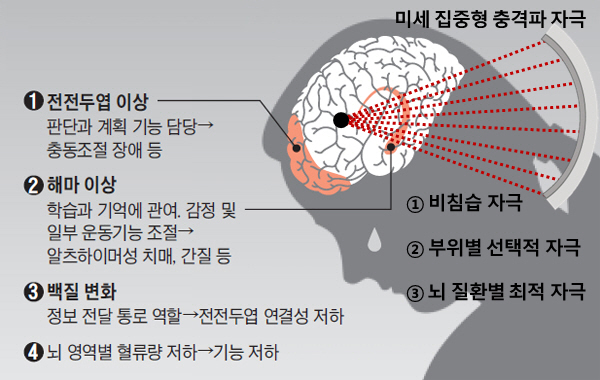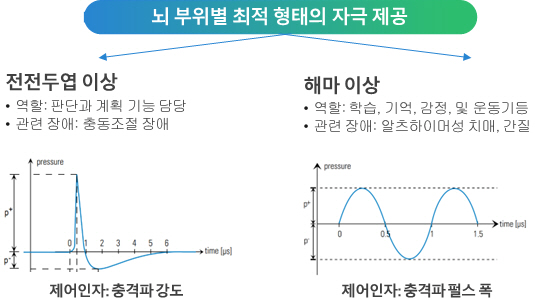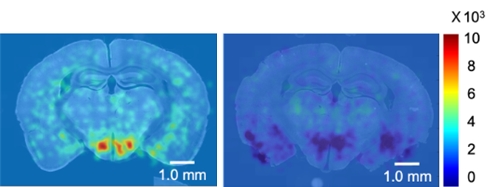Professor Jai-ick Yoh's Research Team at SNU Develops Micro-Shockwave Electronic Therapy for Safe Non-Invasive Treatment of Brain Disorders
- World’s first study to prove the use of cell-specific mechanical stimulation for nerve regeneration
- Promising potential for extending neurosurgical treatment protocols through interdisciplinary collaboration with SNU College of Medicine

▲ (From left to right) Professor Jai-ick Yoh (SNU College of Engineering), Professor Hyung-Jin Choi (SNU College of Medicine), Dr. Hwichan Ham (SNU College of Engineering), PhD candidate Kyu sik Kim (SNU College of Medicine)
Seoul National University’s College of Engineering announced that Professor Jai-ick Yoh's research team from the Department of Aerospace Engineering, in collaboration with Professor Hyung-Jin Choi’s team from SNU’s College of Medicine, has developed a non-invasive micro-shockwave therapy for the safe treatment of brain disorders without requiring surgical incisions.
The research was published on September 1 in Brain Stimulation, an internationally recognized journal in the field of brain stimulation.
Traditional treatments for brain disorders often involve the insertion of metal electrodes into the brain, posing significant risks of bleeding and infection. While non-invasive methods have been developed as an alternative, these approaches face challenges in delivering precise stimulation to deep areas of the brain without causing damage. Additionally, research into optimizing signals for nerve regeneration during treatment has been insufficient.
In response to these challenges, the interdisciplinary research teams from the College of Engineering and the College of Medicine have developed a micro-shockwave electronic therapy that can safely stimulate the brain for nerve regeneration without requiring surgical incisions. This innovative method delivers localized signals to deep areas of the brain, such as the hypothalamus and hippocampus, which are critical for memory function. The therapy has been tested in live models, showing activation of neurons, nerve regeneration, and behavioral improvements, thereby validating its effectiveness.
The results showed that the experimental group treated with the electronic therapy exhibited statistically significant nerve regeneration compared to the control group (see Figure 1, 2 below). The therapy also successfully targeted specific brain areas, with no damage to surrounding cells or other regions of the brain, demonstrating its safety and innovation compared to existing non-invasive methods (see Figure 3).

- ①Non-invasive stimulation: Can induce signals for cell differentiation, proliferation, and regeneration without surgery or incisions.
- ②Targeted stimulation: Delivers focused stimulation to the desired brain area.
- ③Optimized stimulation for different brain disorders: Stimulates cells in specific brain regions according to their characteristics, enabling tailored treatment for various conditions.

- -Example (left): Clinically derived optimized waveform used to induce signals for regeneration, proliferation, and differentiation in the prefrontal cortex cells, applicable to prefrontal cortex-related treatments.

- -(Left) Pressure waveform 1: Shows activated neurons as white dots after stimulation.
- -(Middle) Pressure waveform 2: Shows reduced neuron activation.
- -(Right) Control: Shows neuron activation levels without stimulation, less than waveform 1 but higher than waveform 2.

- -(Left) Brain with selectively activated neurons in the hypothalamus (responsible for physiological regulation), shown as red areas.
- -(Right) Brain without stimulation, showing no activation changes.
This innovative micro-shockwave electronic therapy opens new horizons in non-invasive brain disorder treatment by significantly reducing the risks associated with traditional surgical methods. It not only overcomes the limitations of existing non-invasive methods by allowing targeted stimulation of specific brain areas but also induces various brain cell signals, such as cell differentiation and proliferation, without harming brain function (see Fig. 4). This breakthrough is seen as a major advancement in the treatment of brain disorders.
Professor Jai-ick Yoh emphasized, "This is the world’s first study to prove the use of cell-specific mechanical stimulation for nerve regeneration, making it a groundbreaking achievement. This research has laid a strong foundation for further exploration and collaboration with neuroscientists, leading to the development of new and safe treatment protocols for brain disorders." Professor Hyung-Jin Choi added, "Although this study didn’t directly demonstrate improvements in disease models or memory, it opens new doors for the treatment of brain-related conditions such as dementia, Parkinson's, depression, addiction, OCD, and obesity. We expect it to pave the way for the development of new treatment protocols in neurosurgery."
Dr. Hwichan Ham, one of the lead authors of the paper, received his PhD from Professor Jai-ick Yoh’s SNU Extreme Energy Lab with a dissertation on "Development and Application of Wave Actuators for Non-Invasive Drug Delivery." He has been working for seven years at 'Bazbiomedic,' a startup founded by Professor Yoh, on the development of non-invasive drug delivery medical devices. Co-author Kyu sik Kim is a PhD candidate at Professor Hyungjin Choi’s lab, specializing in the neural circuit mechanisms of the hypothalamus. Meanwhile, Professor Do-Nyun Kim from the Department of Mechanical Engineering at SNU and Ph.D. candidate Jee-Hwan Lee, who is researching finite element analysis for wave mechanics in Professor Kim's AI-driven Simulation and Design Laboratory, also participated as co-authors in the writing of this paper.
[Contact Information]
Professor Jai-ick Yoh, Department of Aerospace Engineering, Seoul National University / +82-2-880-9334 / jjyoh@snu.ac.kr
Dr. Hwichan Ham, Department of Aerospace Engineering, Seoul National University / hamn2012@snu.ac.kr



